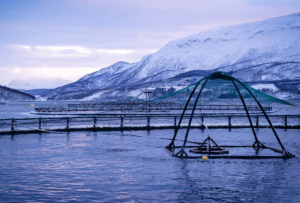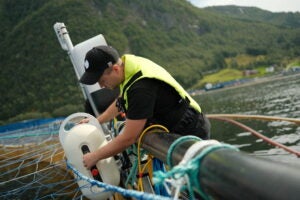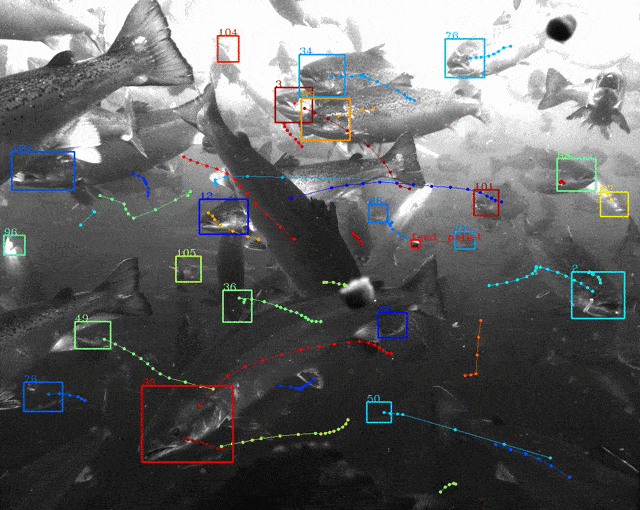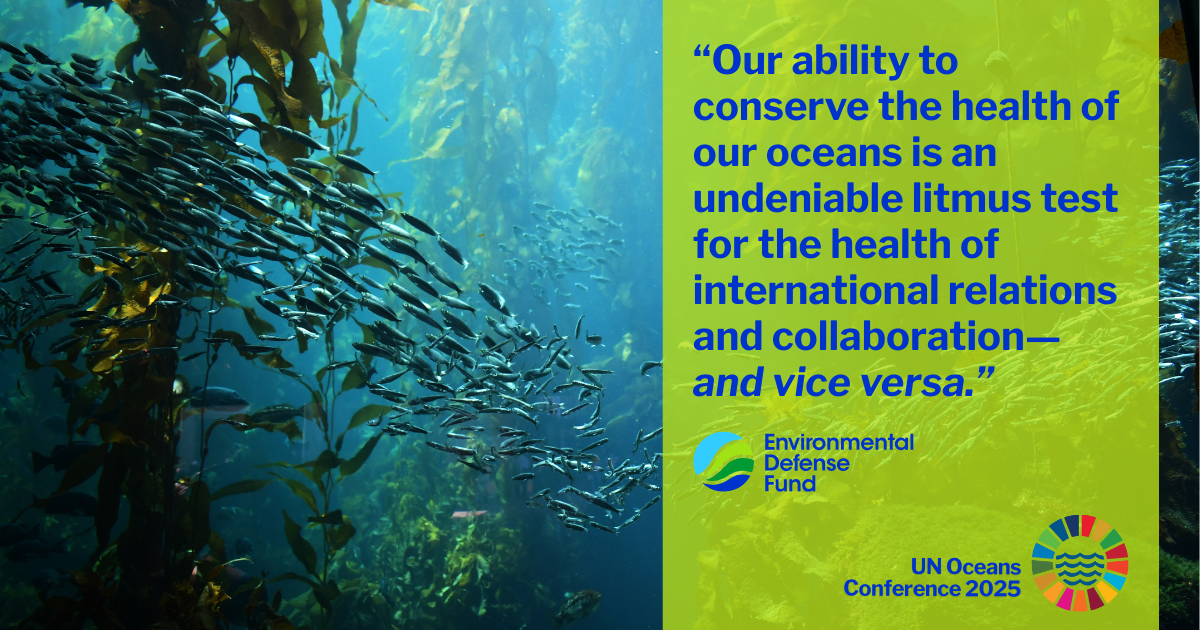
A Look at Science, Technology, and Artificial Intelligence for Sustainable Aquaculture
We’ve come to our final blog in our series on sustainable aquaculture for EDFish. Now that we’ve covered aquaculture feed, escapes, and diseases, we’ll wrap up the discussion with a look at technology’s role in sustainable aquaculture. With appropriate investment and incentives, ocean farming technologies and innovations could address sustainability risks for farming seafood in U.S. federal waters, also known as “open ocean aquaculture.”
To mitigate risks, the U.S. open ocean aquaculture industry needs a clear understanding of the potential role of technology, with targeted research and development (R&D) efforts to accelerate progress toward sustainability. This must be paired with a robust regulatory framework to guide investments in technology and to fill gaps where current technologies fall short of mandated environmental protections.
More information can be found in EDF’s white paper “Sustainability Considerations for the Expansion of US Open Ocean Aquaculture: Unleashing Advances in Science, Technology, and Artificial Intelligence to Support Sustainable Open Ocean Aquaculture in the US.”
What are the risks?
Open ocean aquaculture entails unique sustainability and logistical challenges. Due to the open ocean environment’s deeper waters and stronger waves, farm infrastructure is more difficult to install and faces more wear and damage, creating additional maintenance needs and risk of animals escaping.
Visiting farms for maintenance, inspection, or health services requires longer trips in potentially rough conditions. Additionally, open ocean aquaculture must contend with sustainability challenges common to both aquaculture and terrestrial agriculture, such as responsibly sourcing feed as well as detecting and treating diseases.
Aquaculture research and development funding lags behind

Although aquaculture is the fastest-growing food production sector in the world, U.S. federal research investment has been modest. From 1990 to 2015, the U.S. government spent $1.04 billion on aquaculture research and development, compared to $41 billion for terrestrial agriculture. Similarly, philanthropists and global grantmakers spent less than one tenth on aquaculture as they did for fisheries from 2016-2021. This is a major missed opportunity: researchers calculated a 37-fold rate of return on federal aquaculture research and development funding since 2000.
Minimizing risks via technology: Promising areas of innovation
Improving feed sustainability and efficiency. Researchers and industry are developing precision formulas and novel ingredients to deliver optimal nutrition with minimal environmental impact. But, more funding and research are needed to bring these innovations to scale. Precision genetics has improved farmed species’ feed conversion efficiency, and these efforts could be enhanced to promote other desired traits like disease resistance or sterility.
Optimizing farm design and materials to reduce costs and minimize escapes. Sophisticated modeling systems and NOAA’s Atlases of Aquaculture Opportunity Areas (AOAs) enable aquaculture applicants to site farms to reduce water quality impacts. New infrastructure designs and materials, such as pens that can be submerged during inclement weather and predator-proof mesh fibers, reduce impacts on ocean habitat, increase durability, and reduce escape risks.
Supporting animal health. Innovative research into disease approaches that reduce antibiotic resistance is ripe for further investment and application in more species. Autogenous vaccines that are rapidly developed for facility-specific outbreaks provide targeted and flexible responses for new or evolving pathogens. Scientists are harnessing naturally derived compounds from fish immune systems to quickly eliminate pathogens without developing resistance.
Automating and optimizing ocean farming advancements with artificial intelligence (AI). AI and machine learning algorithms, combined with continuous remote monitoring technologies, have been used to optimize feeding, detect disease early, and spot escapes with minutes. Farmers can use drones and unmanned vehicles to maintain facilities and monitor farm conditions remotely, enabling rapid responses to environmental changes. These technologies save time, money, and emissions-intensive travel to open ocean pens.
Blockchain for traceability. Major seafood companies are increasingly using blockchain technology to trace aquaculture products as they move through supply chains. RFID tags can identify individual fish with information about their origin, farming practices, and transportation history. These key traceability tools enable aquaculture producers to demonstrate responsible sourcing practices. However, a lack of standardized traceability practices currently limits data exchange and interoperability.

Recommendations to advance sustainable US aquaculture
For federal and academic researchers:
- Explore potential for repurposing decommissioned energy infrastructure in the Gulf of Mexico for aquaculture development, and co-location of aquaculture facilities with offshore renewable energy platforms (e.g., Gulf Offshore Research Institute in coordination with the Department of Energy, NOAA, and the Bureau of Oceans Energy Management).
- Expand genetic sequencing for commercially promising native species.
- Investigate production methods for low-cost, rapid diagnostics that can be used onsite.
For federal regulators:
- Implement experimental permitting and consider longer permitting timeframes to align with the necessary research to incentivize financing and kick-start innovations.
- Prioritize experimental farm proposals that will research polyculture and integrated aquaculture, especially with native seaweeds.
- Evaluate how underwater and airborne drone operation rules can and should be adapted for aquaculture facility operations.
- Develop aquaculture industry-wide traceability standards (as recommended in the FAO’s Voluntary Guidelines for Sustainable Aquaculture).
For Congress:
- Establish a U.S. federal management system for aquaculture, parallel to U.S. fishery management, based on science with multistakeholder engagement.
- Increase federal support for basic and targeted open ocean aquaculture research, including incentives for industry, academic, and government partnerships.
- Require that federally funded aquaculture research results be publicly accessible.
As we reach the end of our aquaculture sustainability blog series, we return to the question posed at the beginning of the series: Is aquaculture sustainable? Now that we’ve taken a deep dive into the many nuances of aquaculture, we hope you’ll see we the answer to that question is “it depends.”
Moving forward sustainably with aquaculture means we must embrace these nuances and understand that solutions and innovations will require careful thought, comprehensive scientific study, and collaboration. In doing so, we can ensure that we have an aquaculture industry that minimizes environmental risks, serves communities, and nourishes people.
Photo and videos courtesy of Tidal.












